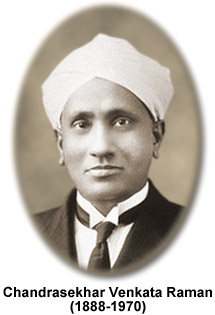Chandrasekhar Venkata Raman
(1888-1970)

When Chandrasekhar Venkata Raman was born in Trichinopoly, Madras, India on November 7, 1888, there was little opportunity for inhabitants of the country to pursue scientific research as a career. Yet, this setback did not hinder Raman, the son of a college lecturer and the second of eight children. Instead, throughout his lifetime Raman would consistently create his own opportunities, at the same time changing the scientific climate of India and heightening the prospects of his countrymen.
Raman was educated at the Presidency College in Madras where he graduated at the top of his class. Afterwards, he considered relocating to England to continue his studies, but decided to remain in his homeland, where he enrolled in the masters program in physics at Presidency College. Allowed to pursue his own interests, Raman conducted experiments involving the diffraction of light through rectangular apertures and compiled his findings into a manuscript that he submitted to the Philosophical Magazine in London. Their publication of the work was particularly remarkable since it was the first article to originate from Presidency College and its author was only eighteen years old.
Having completed his M.A. in 1907, Raman was faced with the harsh reality that there was no place in India where he could pursue physics research professionally. Thus, he sat for a competitive examination for a government post in finance. He won the coveted position and for the next ten years carried out independent research while simultaneously fulfilling his professional duties in Calcutta. The pertinence of his work led Calcutta University to offer him their first endowed physics chair in 1917, a position he accepted despite the fact that it would pay significantly less than his governmental post.
It was during his years at Calcutta University that Raman made what would be his primary contribution to optics. While studying light diffraction, Raman discovered that when an intense light was passed through a transparent medium, a small fraction of the light surfaced in directions other than the incoming beam, and an even smaller part of this fraction of light exhibited different wavelengths than the incident light. After his findings were made public in 1928, the scattering of the light molecules came to be known as Raman scattering, which was considered a result of the Raman effect, the change in wavelength of light when it is deflected by molecules. Though the Raman effect is weak, its discovery greatly impacted future research regarding molecular structure and radiation. The importance of Raman’s discovery was widely recognized, and he was knighted by the British government in 1929 and awarded the Nobel Prize for Physics a year later.
In 1933, Raman left Calcutta University to head the physics department at the Indian Institute of Science in Bangalore. During his time at the institution, he carried out a study with his colleague Nagendra Nath, which resulted in the development of the Raman-Nath theory on the diffraction of light by ultrasonic waves. He also influenced a great number of students and founded the Indian Academy of Sciences as well as the Indian Journal of Physics as forums to promote scientific discussion and debate. Raman retired from the university in 1948 and soon opened the Raman Research Institute, an establishment that he personally planned and carried out the fundraising for. He continued his research there for many years—ultimately publishing over 450 papers over the course of his lifetime—before his death on November 20, 1970. His ashes were scattered among the trees surrounding the institute.
